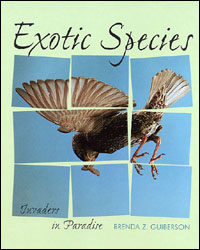





 |
 |
 |
 |
 |
 |
|
|
Titles - Where to Buy Books - About the Publisher | ||||
|
|
 |
Exotic Species: Trouble in Paradise
Written by Brenda Z. Guiberson Twenty-First Century Books, 1999
Sometimes the traveler finds itself in a new place where the climate is perfect and the food is plentiful. Best of all for this invader, the predators and diseases that usually keep it in check do not exist in this new home. As a result, its population will multiply with breathtaking speed. Quickly it can cause the extinction of species already in the area.
Exotic species are one of the biggest problems for the natural world today. To save what we can of our unique environments, we must identify and understand the threat of exotic species.
What happens when a new and different species of plant or animal is introduced into an ecosystem? This book provides an answer to
that question by examining a variety of these "exotic" species and their impacts on their new homes. The first chapter sets the stage for
the discussion with a look at animal relationships and nature's own system of checks and balances. The following chapters focus on
individual species such as the starling, zebra mussel, and kudzu vine. The discussion is well balanced; the author is careful to look at both
the positive and negative aspects of these invasions. However, the reality is that the harm the invaders cause usually outweighs any
initial good, and the examples provided make this fact abundantly clear. Methods of controlling exotic species are also examined. The final
chapters look at the actions humans are taking to help restore natural balances to environments that have become victims to these invasions.
The text is well written in clear, lively language. The accompanying color photos help to illustrate the subject under discussion. --School Library Journal |
|
|
|
| Copyright © Brenda Z. Guiberson, 2004-Present | Contact Brenda | Site/Art Credits |